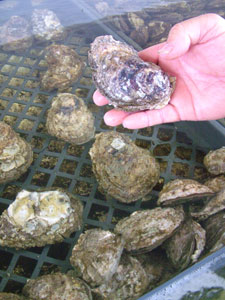Sea Grant researcher makes interstate ‘stud runs’ to improve oyster breeding
 John Supan, a research professor, oyster specialist and the director of the Louisiana Sea Grant Oyster Research Lab for LSG and the LSU AgCenter, has been on a decades-long quest to build a better oyster on Grand Isle. Most creatures are diploids, meaning they have two sets of chromosomes—one from each parent. Supan has worked to produce triploid oysters, which have three sets of chromosomes. These animals are sexually sterile, produce greater meat yields—especially in the summer months when diploid oysters expend their energy on breeding—and require less time to grow to a marketable size. Evidence also suggests triploids are more resistant to the diseases that damage oyster crops. These qualities translate into economic benefits for oyster growers.
John Supan, a research professor, oyster specialist and the director of the Louisiana Sea Grant Oyster Research Lab for LSG and the LSU AgCenter, has been on a decades-long quest to build a better oyster on Grand Isle. Most creatures are diploids, meaning they have two sets of chromosomes—one from each parent. Supan has worked to produce triploid oysters, which have three sets of chromosomes. These animals are sexually sterile, produce greater meat yields—especially in the summer months when diploid oysters expend their energy on breeding—and require less time to grow to a marketable size. Evidence also suggests triploids are more resistant to the diseases that damage oyster crops. These qualities translate into economic benefits for oyster growers.
Now, Supan is engaging in technology transfer to help other bivalve hatcheries and farms and to expand available broodstock for triploid production across the Gulf of Mexico. One method for producing triploids is to create tetraploid males, which have four sets of chromosomes, and to breed them with diploid females to produce the desired triploid offspring. Supan said it took 10 years to make his first tetraploid oyster and the process can be arduous. Today, he is personally enabling the use of tetraploids by making what he calls “stud runs” to deliver male oysters to facilities in Alabama and Florida so they can produce triploids.
Supan began his work with triploid oysters in a collaboration with Stan Allen at Rutgers University. Allen, along with Ximing Guo, developed triploids and patented their process in 1994. Allen and Guo’s method uses sperm from tetraploid oysters to fertilize eggs from non-altered diploid females. The offspring of the process are referred to as natural triploids. 4Cs Breeding Technologies, Inc., in Strathmere, N.J., manages the technology and issues licenses to hatcheries and farms wishing to use it. Supan has been working with Tom Rossi from 4Cs to distribute tetraploids in the Gulf of Mexico.
“At Sea Grant, we are the leading polyploidy breeding program,” he said. “Now, we are fostering commercial development with this technology transfer. We have given the Auburn University Shellfish Lab on Dauphin Island its own tetraploids to manage so they can have their own ripe males when they choose. We have also given Southern Cross Sea Farms in Cedar Key (Florida) their own tetraploids. This was all done in agreement with 4Cs.” Auburn uses the tetraploids for research. Southern Cross previously focused on clam production but has expanded its operation to include oysters, a transition that Supan said is working well.
Supan still employs other methods to produce triploids, noting the importance of having a diverse broodstock.
“We continue the tetraploid lines, and we are improving the line. We want to avoid a genetic bottleneck. Starting from a small gene pool is not good. At one point, we only had 10 tetraploids. We always need to expand the gene pool with our broodstock. You have to always be mindful that you started with a small group of animals and work constantly to fold in new genes. We have a lot of research to do to improve the tetraploid gene pool.”
On the web:
4C’s Breeding Technologies, www.4cshellfish.com
Louisiana Oyster Dealers and Growers Association, www.louisianaoystersdealersandgrowersassn.org
